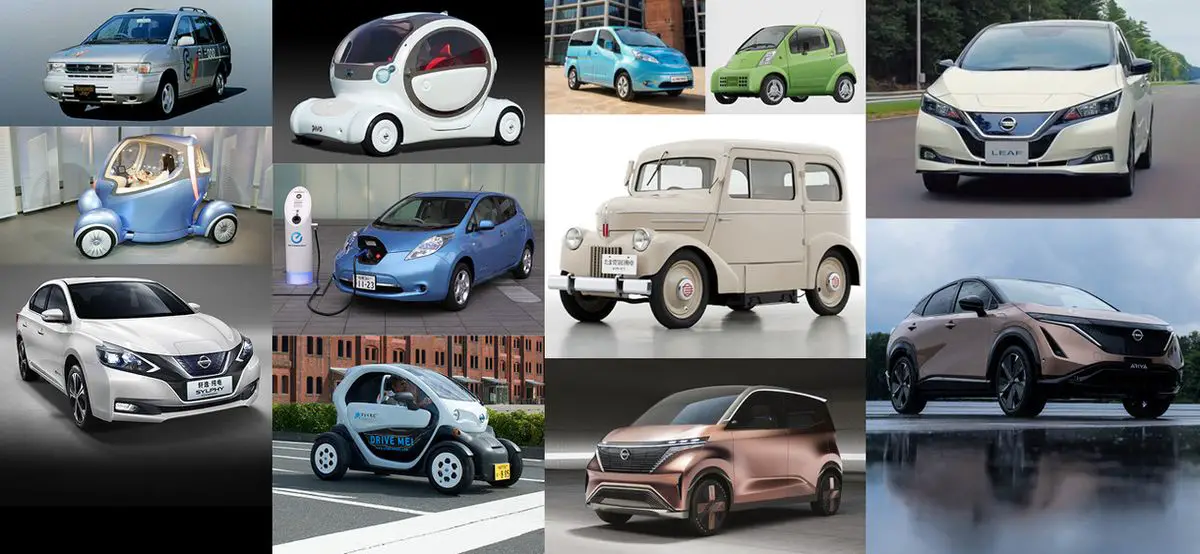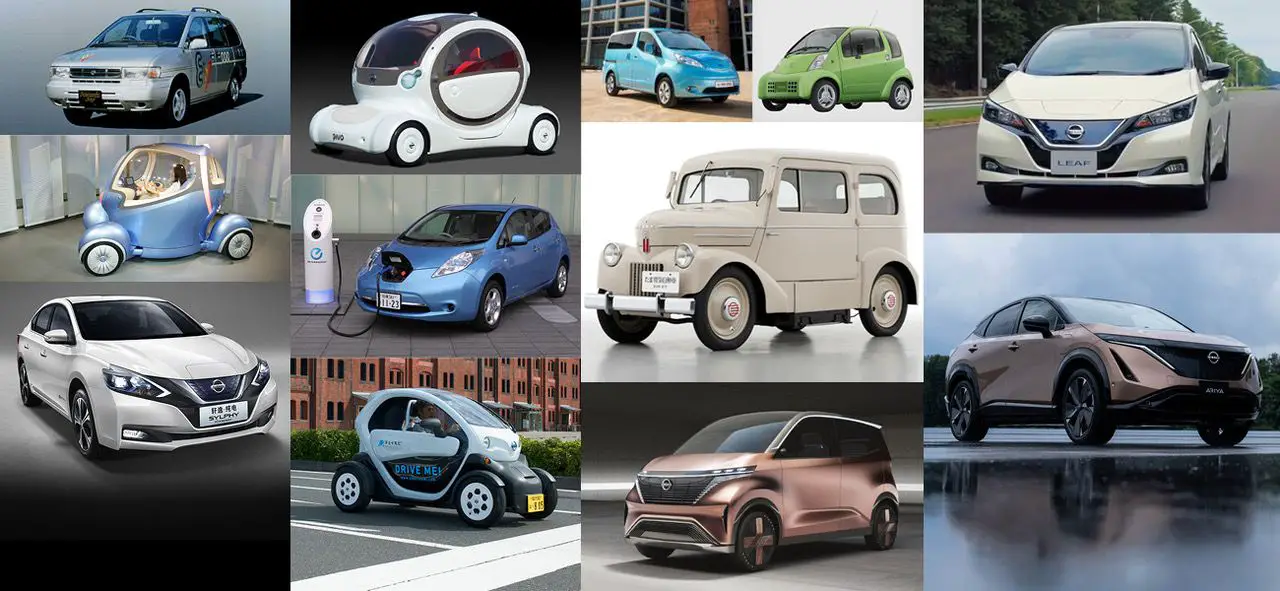Nissan's Decade in Electric Innovation: From Leaf to Ariya SUV.
For more than a decade Nissan has been electrifying the roads from the Nissan Leaf to Ariya. The Nissan LEAF laid the foundations of modern-day electric vehicles.


After World War II, Japan did not have much oil but could generate electricity enough for all, the Japanese government asked its country’s engineers to try to make some electric vehicles. The Tokyo Electric Cars Company, which later became part of Nissan, obliged.
For more than a decade Nissan has been electrifying the roads from the Nissan Leaf to Ariya. The Nissan LEAF laid the foundations of modern-day electric vehicles. The pioneering LEAF hit the roads in December 2010, hence celebrating more than 10 years of the all-electric LEAF, the world’s first mass-market electric vehicle (EV). It was first sold in Japan, Europe, and America and is now driven in 59 markets. Currently, more than half a million Leaf electric vehicles have been sold.
Nissan kicked off the 1970s by unveiling its vision of the future for electric city mobility at the 17th Tokyo Motor Show - the 315X concept car. It was never put into production but it was quickly followed by the company's first electric commercial vehicle - the lead-acid battery, DC motor-powered EV4-P.
The Leaf is Small in size but big on innovation, By reimagining the idea of what a car is, the LEAF is helping customers, cities, and governments create a more sustainable future. It’s doing this by going beyond mobility and exploring new ways for electric vehicles to plug into everyday life.
The LEAF’s battery technology is helping power homes and businesses, while broader Nissan EV innovation is at the heart of vehicle-to-grid energy management services. LEAFs are also helping out during disasters.
In 2014 Nissan unveiled its electric commercial vehicle the E-NV 200 van with a 273km (169-mile) range.
Read: Nissan Leaf
2010: History of LEAF becoming the first EV to win an award.
Nissan's vision was to tackle urbanization and industrial development by building a car that emits no carbon dioxide but is still loads of fun to drive. The first-generation LEAF had powerful acceleration and handling, delivering smooth driving performance. Unique features allowed drivers to use their cell phones to check the car's battery level or manage air conditioning remotely. A 24-kilowatt-hour lithium-ion battery powered the first model. Fully charged, it had a range of 200 kilometers.
See: Nissan Leaf the top-selling electric car
Nissan worked with governments, municipalities, and electric power companies to promote electric vehicles and develop an extensive charging infrastructure. When the LEAF first arrived, Japan had about 200 CHAdeMO1-standard quick chargers. Today, there are more than 30,000 of these chargers around the world. Since then LEAF has been making history by becoming the first electric car to win a string of prestigious awards including European Car of the Year 2011, World Car of the Year 2011, and Japan Car of the Year 2011-2012.
2012: A car that powers your home
Two years later, Nissan became the first global company to unveil a system that lets customers share power between their homes and cars. With the Vehicle-to-Home (V2H) system, LEAF owners could store energy in their car batteries and feed it back to their homes whenever they wanted. They could charge the car's battery when demand and rates were low and use it around the house during peak times.
At the same time, the LEAF began to make a difference during natural disasters that interrupt electricity supplies. It served as an emergency power supply on wheels, which could also store energy where needed. On the Hawaiian island of Maui, the LEAF took part in a smart grid project, helping stabilize the power network.
2012: Range boost to 228km per single charge.
Several improvements were made to the electric powertrain that gave the leaf more power and extended its range to 228 km per single charge. A sign of relief to the drivers. More range didn't mean bigger components. In fact, the new electric powertrain was smaller. The volume was reduced by 30% and mass by 10%. Reduced power consumption also enabled new perks, like heated seats and steering wheel. In 2014, LEAF sales broke through the 100,000 mark.
2015: Second range boost
Battery improvements began to accelerate. The LEAF has a 30 kWh battery and a range of 280 km, all without compromising cabin space or charging time. Even with the added capacity, the new battery could be charged to 80% in the same time it took to charge its predecessor.
The update also included new safety technologies. These included Intelligent Emergency Braking, which uses a front camera to detect vehicles and pedestrians.
The LEAF celebrated its fifth anniversary just before sales hit 200,000 vehicles.
See: 4 Interesting Things About Nissan's e-4ORCE Technology
2017: Breakthrough moment: Second-generation LEAF offers 400km range, e-Pedal and ProPILOT technology
It was time to make history again. The second-generation LEAF introduced unprecedented technologies that boosted enjoyment, convenience, and efficiency. These included the e-Pedal for one-pedal driving and ProPILOT advanced driver assistance. A new electric powertrain increased power output by 38% to 110 kW and torque by 26% to 320 Nm, providing an exhilarating driving experience. The new lithium-ion battery was no bigger than those that came before, yet had 67% more energy density than the 2010 model and offered a range of 400 km.
In 2017, the LEAF headlined Nissan's first car-sharing service in Japan, called e-share mobi. This allowed everyone to experience Nissan's latest EV and its driver assistance technologies. By early the following year, 300,000 LEAFs were on the roads worldwide.
2018: Beyond mobility: Nissan Energy offers new ways to use the LEAF
With innovation from the Nissan Energy program, the LEAF became even more useful to owners. Through smart storage and charging, the car could better share energy with a home or a business. The Nissan Energy Home, a demonstration of Nissan Energy's work and ideas, was unveiled at the Nissan Global Headquarters Gallery in Yokohama.
Nissan developed systems to reuse and recycle old batteries. 4R Energy, a Nissan affiliate, opened a plant in the town of Namie, Futaba District, Fukushima Prefecture in northeastern Japan, which focused on re-using EV lithium-ion batteries.
Related: Nissan Leaf Nismo
Innovation to get the heart racing: Development of the Nissan LEAF NISMO RC
After the success of the LEAF, Nissan saw an untapped potential in electric cars and created the LEAF NISMO RC (Racing Competition). Motorsport fans around the world witnessed the quiet but exciting zero-emission driving experience offered by Nissan's electrification technologies.
The first-generation NISMO RC was built in 2011 with the same battery, motor, and inverter used in LEAF production cars. They were installed in the center of the vehicle to create a rear-wheel-drive system.
The second-generation NISMO RC came in 2018. It was revamped and given twin motors, four-wheel drive, and an aggressively styled body. The lithium-ion battery and inverter used technologies from the second-generation Nissan LEAF, with the motor producing 240 kW of power and 640 Nm of torque. It was twice as powerful as the 2011 model.
2019: A new arrival: The top-end Nissan LEAF e+
A new electric powertrain gave the Nissan LEAF e+ a more powerful motor and extended range. Its 62 kWh battery had 55% more capacity. This change pushed the car's range to 458 km2, again without sacrificing space or design. What stayed the same was the instant torque that makes the LEAF so fun to drive. By 2019, more than 400,000 customers around the globe had bought a LEAF.
Read Nissan's $18 bln electrification project.
The Ariya - Nissan's first all-electric crossover SUV - offers powerful acceleration and smooth, quiet operation, as well as an interior with a welcoming, luxurious lounge-like atmosphere. Its stress-free autonomous driving features, concierge-like assistance, and seamless connectivity heighten on-road confidence and provide a welcoming environment for the driver and passengers. With an estimated range of up to 610 kilometers (based on the Japan WLTC cycle, subject to homologation), the Ariya is the perfect partner for daily commutes and road trips alike.
Also read: Nissan unveils its first electric SUV
In 2021 the Ariya electric SUV was available for purchase. The Ariya sports bold styling and is sold in a number of variants, including a single-motor front-wheel and twin-motor all-wheel drive with a choice of a 63 or an 87kWh battery and ranges of up to 482km (300 miles).
The twin-motor powertrain utilizes Nissan’s new e-4ORCE four-wheel drive system, which it calls the “spiritual offspring” of the system used in the barnstorming Nissan GT-R. The range-topping e-4ORCE performance model will produce 389bhp and cover 0-62mph (0-100kph) in a claimed 5.1 seconds.
The hype is real with Ariya and Nissan’s future manufacturing of electric vehicles given its 70-year, pioneering past. With a 100% electric powertrain, the Ariya promises powerful acceleration and smooth, quiet operation. Drivers and passengers can relax and enjoy the ride thanks to autonomous driving technology, concierge-level assistance, seamless connectivity, and a spacious, lounge-like interior. With an estimated range of up to 610 kilometers1, the no-compromise Ariya is perfect for daily commutes and weekend road trips alike.
CEO Makoto Uchida and Chief Operating Officer Ashwani Gupta unveiled the Ariya to a global audience during a live-streamed event at the new Nissan Pavilion in Yokohama. Gupta said the Nissan Ariya is a truly beautiful and remarkable car, that enables someone to go further, easier and in comfort. The Ariya is designed to impress and express what Nissan strives for by making its customers' lives better.
Source




